Agile leadership is a set of values and principles that helps leaders guide their teams to become fully self-organized while delighting customers.
The concept of agile leadership originates from various frameworks, including the OODA-loop, VUCA environments, and agile methodologies such as scrum or kanban.
These topics are already covered in other publications.
» DOWNLOAD NOW: Agile Readiness Assessment for Your Organization
In this article, we’re going to focus on what agile leadership is and how it can benefit the sustainability and growth of your organization.
What Is Agile Leadership?

Before we get to describing what agile leadership is and how it benefits your organization or the company you work for, we need a working definition:
Agile leadership is the process of getting work done through others by embodying and embedding agile values, agile principles, and empowering agile teams.
This begs the question of what agile values, principles and teams are.
It’s important to note that while holistic in nature, agile leadership is not a replacement for basic leadership practices but rather an extension of them.
I’ll tell you why in just a moment.
The Foundational Values of Agile Leadership
Anyone interested in leadership and agile methodologies should understand the four foundational values that allow for an agile approach:
1. Individuals and Interactions Over Processes and Tools
While tools and processes are valuable, they’re not as important as individuals and interactions. That’s what the agile manifesto teaches us and it’s also one of the most important values in agile leadership. If you can’t find a way to put the people that work on your behalf first, then you’re failing to see the bigger picture. Listen, understand, plan, align, and act. These are the rules of team interaction over corporate compliance.
2. Working Products or Services Over Comprehensive Documentation
The original definition of this was in regards to working software. However, agile methodologies have spread across multiple industries (education, health care, manufacturing, and more) so a more appropriate definition is to consider the broader “products and services” spectrum. Having those products and services positioned against your customers’ needs is a fundamental agile value.
3. Customer Collaboration Over Contract Negotiation
Contracts are annoying. They take a lot of time to create and edit based on the needs of the customer but they never truly fit. That’s because they try to tackle everything all at once. Being agile is different. It takes courage to tell your customers that success is more about the journey than the final solution but once you convince them that collaboration is key, they see the benefits and stick around far longer.
4. Responding To Change Over Following a Plan
Change is everywhere. In leadership, there’s never been a shift as strong as the one brought by digital transformation. Everyone thinks that technology is the key to unlocking unprecedented potential but, in reality, it’s the people behind those technologies that are disrupting the way we do things. As leaders, we need to find a response. Plans are great but responding to change is more important.
These four values make up the foundation of agile as a whole.
Without a firm belief in them, it’s almost impossible to foster a culture where people in a team can elevate each other. As agile leaders, we want to embody and embed these values in our organizations.

Understanding The 12 Principles of Agile for Leadership
Agile principles vary from simple concepts to keystones that allow teams and organizations to reach a sustainable, long-term outlook for product or service development. Here are the twelve core principles of agile leadership:
- As a leader, you must ensure that the products or services your teams develop are delivered to your stakeholders as early as possible and are viewed as valuable.
- Agile leaders are always trying to help their internal and external customers succeed. This means helping them gain and maintain a competitive advantage.
- Agile leaders help their team deliver working products or services frequently, from a couple of weeks to a couple of months, with a preference to the shorter timescale.
- In agile teams, businesspeople and product developers and/or technicians should work together daily throughout the entire span of the project. This ensures alignment.
- Building projects around motivated individuals is essential. Agile leaders give them the environment and support they need and trust them to get the job done.
- In agile, sustainable product or service development is promoted when sponsors, developers, and users maintain a constant pace indefinitely.
- Similarly, a working product or service is the primary measure of progress.
- Daily face-to-face conversations are the most effective and efficient way to convey information within an agile development team—leaders included.
- Continuous attention to technical excellence and good design greatly enhances the agility and, ultimately, the productivity of a team.
- In agile teams, simplicity trumps complexity—every single time.
- The best architectures, requirements, and designs emerge from self-organized, self-motivated teams with people who elevate each other.
- At regular intervals, an agile team should reflect on how to become more effective to then tune and adjust its behavior according to change.
By embedding these principles into your organization, you are effectively implementing an environment where employees feel empowered to do what feels best according to their knowledge, experience, and work ethic.
This is a key component of agile leadership.
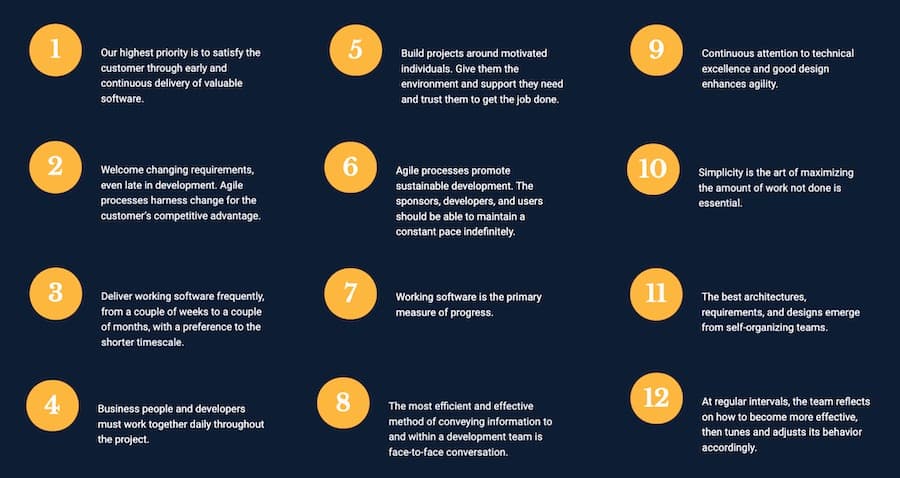
Elevating Teams To Become Agile Through Great Leadership
Building a team of self-organized, highly motivated people is the best way to achieve results that last. This is what agile leadership is all about and it requires a firm belief in people’s ability to get things done on their own.
As correctly reported by Atlassian, an agile team is built upon a solid foundation and grows over time by keeping the four phases of group development in mind:
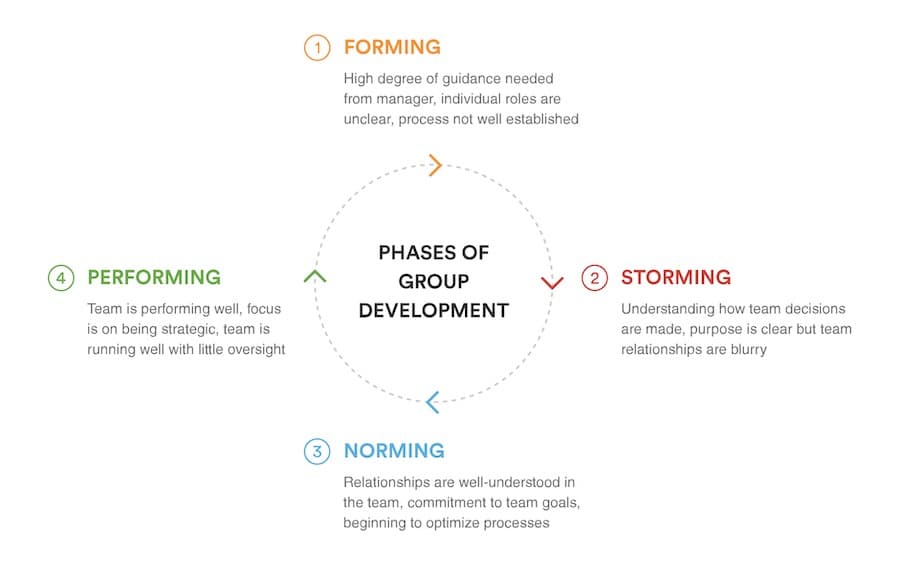
Understanding this cycle is crucial for responding to change.
In a traditional environment, a team would plan their every move before they would start working on a project.
Agile leaders should help teams break out of this behavior by not only mentoring their peers on the values and principles of agile but also applying them on a daily basis.
There are two key components to this equation:
- Peer-To-Peer Mentoring
- Shared Knowledge
Professionals working in a team that’s backed up by agile leaders should mentor each other without much attention paid to seniority or hierarchy.
Everyone learns from the other.
That’s why the best agile teams also build a culture of shared knowledge and cross-training where a professional can replace another professional and vice versa.
Professionals working in a team that's backed up by agile leaders should mentor each other without much attention paid to seniority or hierarchy. Share on XThis takes time.
There’s no magic to it.
As the team progresses through the four stages for each cycle of their project, they reach what’s known as the performance stage.
This is where the team truly shines in terms of productivity.
Without a firm belief in the foundations of agile management as well as sound development practices, reaching the performance stage is unlikely for any team.
Leadership & The Broader Agile Spectrum

Now that you have a good understanding of the foundations, it’s important to look at the wider agile spectrum and how leadership fits into the bigger picture.
You may (or may not) be aware of the fact that agile methodologies stem from the need for cyclical feedback in projects involving software development.
However, they have proven effective in other industries.
While software development requires iterative approaches that are correlated to agile methodologies, non-IT companies have found great value in applying them as well.
So, is agile the right approach for your industry?
Let’s take a closer look.
The Difference Between Traditional & Agile Leadership
Before I get to the industry statistics, it’s important to understand the key differences between traditional and agile management.
In a quote from organizational consultant Esther Derby:
Traditional managers make sure people do things right. Agile managers make sure people do the right things.
This may sound a bit abstract but it’s true.
In traditional environments, managers love to take control of every resource at their disposal. In fact, you’ll often hear employees being referred to as “resources.”
This is not a good look.
While the nature of leadership is to get work done through others, it shouldn’t come at the expense of the employees and contractors who are hired to do it.
This fosters a culture where the boss cannot be trusted.
With agile leadership, not only is the boss able to empathize with their employees, but they’re also an active part of the team, making sure the operation is running smoothly.
Agile leaders do not micromanage!
This is against the core principles of agile.
Instead, they foster an environment of trust, collaboration, and unbiased feedback. Valuing outcome more than output, agile leaders care about impact most.
What Agile Leadership Brings To The Table
As I mentioned at the beginning of this post, agile leadership is an extension of basic leadership practices—not a replacement.
Implementing agile in a leadership role is also an iterative process; there’s no cookie-cutter solution as management needs vary across industries.
Here’s a basic framework for agile leaders to build upon:
1. Steer Focus
In many cases, you will already have some ongoing projects. And even if you don’t, steering focus is an essential part of implementing agile in your organization. If you can’t align expectations with your team every day, they will likely revert back to planning every single detail of the project, leading to a stagnant development process.
As an agile leader, you should help your team steer away from that thinking and find a balance between their work and the overarching business goals. Great agile leaders are able to remove roadblocks and maintain order without micromanaging or pushing their ideas. They listen, understand, plan, align, and act—every single day.
2. Foster Collaboration
We all hear the term collaboration these days. It turned into a bit of a buzzword but the benefits of it are clear. A team of individuals who understand each other’s strengths and weaknesses and who are highly collaborative are more likely to produce the relevant outcomes. As an agile leader, you should foster this type of environment.
While individuals are a key component of the agile values, agile leaders do not manage individuals one by one. Instead, they assign feature items to the entire team so that the people within can come together and solve the problem as a whole. The spirit and ultimate value of agile is to help the group become a truly self-organized team.
3. Build Trust
Without trust, you’re only a boss to your team, not a mentor. In agile leadership, you want to erase that type of mentality. The boss is the customer. Everyone within the team should be laser-focused on solving the problems that are central to the success of your customer. Building trust means living and sharing this journey with your team.
In traditional organizations, employees often do not trust their managers and leaders, especially in the enterprise category. They see them as the people who can terminate them in a minute if they wanted to, and this builds a toxic relationship between the two figures. Building trust is crucial to ensuring that employees feel welcome and safe.
4. Prioritize Outcomes
Outcome equates to impact for the customer while output equates to amount of work produced in a set timeframe. Which one do you think the customer cares about most? If a feature or product is shipped in time but it doesn’t meet client expectations, it doesn’t really matter that it was shipped at all…
Outcome trumps output in agile approaches.
As an agile leader, you should always focus on outcomes. One of the best ways to do this is to constantly communicate with your clients and let them know what you’re working on and how the team is adapting to the challenge. Reducing output to focus on outcome may sound counterintuitive but it puts emphasis on impact, not deadlines.
With these four simple concepts, your organization is one step closer to fully embracing agile. For more information on this, check out my free guide on how to determine whether your organization is ready to go agile.
The Statistics & Benefits of Agile Across Industries
With a full view on the world of agile and the opportunities that it brings to leaders and teams all around the world, we can dig deeper into the data for each individual industry and how you can take advantage of it.
According to CollabNet’s 13th Annual State of Agile Report, 15% of the 1,319 total respondents are in a leadership development role:
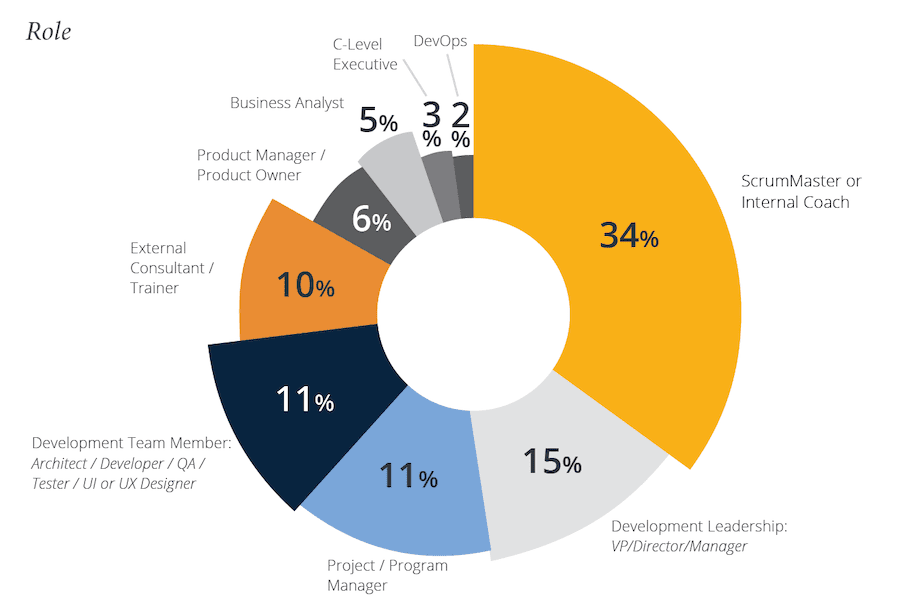
This statistic represents a huge opportunity for people in educational consultancy or leadership development roles who operate in the following industries:
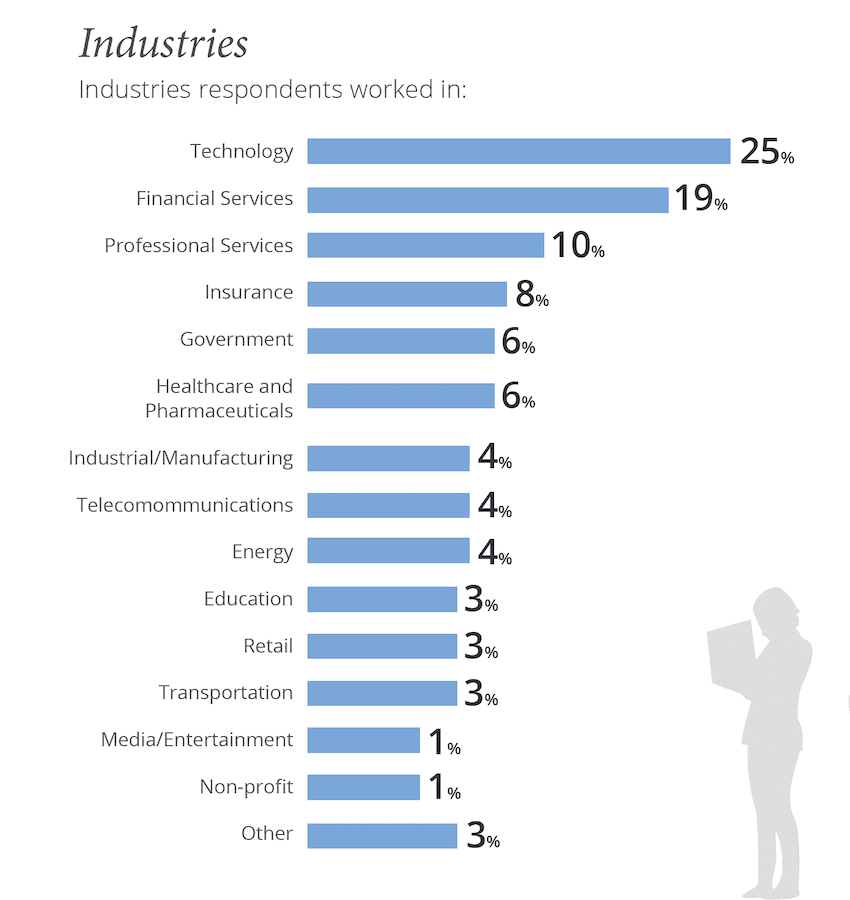
It’s worth noting that while these numbers are revealing, they don’t necessarily represent the real trends that are happening in each industry.
For example, the learning and development industry (a function of business education) has seen increased demand in the past years.
The main reasons for adopting agile across industries are to accelerate product delivery, enhance change management, improve productivity, and align priorities:
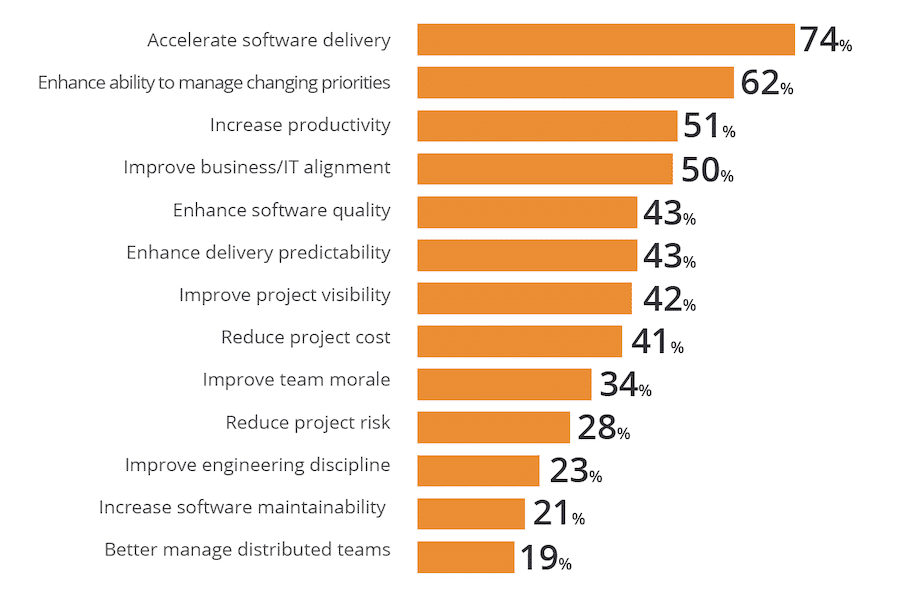
Finally, the respondents reported on the benefits of agile, ranging from enhanced change management to boosted team morale as well as business alignment:
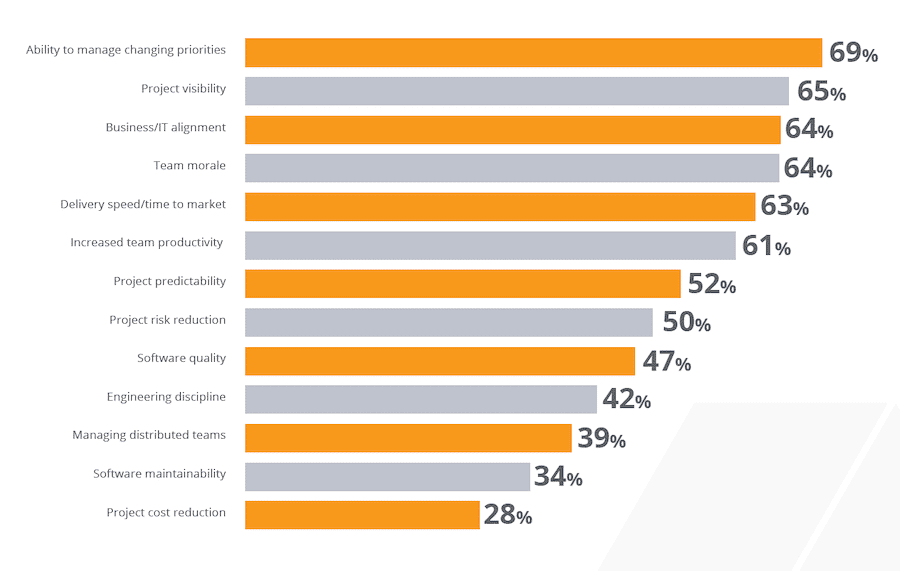
All of this data tells us that agile methodologies are a fantastic way to adapt to change and use it to our advantage, especially in fast-paced business environments.
This information is great news for educational consultants whose job is to advise leaders in their organizations and convince them that agile is the right step to take.
I highly recommend that you grab your own copy of the report (linked above) and you take a look at all the major areas of agile that could fit your industry best.
Why Leaders & Organizations Are Going Agile

With digital transformation happening across the entire business spectrum, leaders are leveraging agile for continuous change management.
The benefits of agile methodologies are clear:
- Enhanced Priority Management
- Better Business Alignment
- Boosted Team Morale
… and more.
With all these reported benefits shared by industry leaders, it’s hard not to become enamored with agile values and methodologies.
They simply work the way they were designed to.
Switching from a traditional leadership style to an agile leadership style isn’t an overnight endeavor though. It will require total buy-in from stakeholders.
So, is your organization ready to go agile?

Originally published May 26 2020
Don’t forget to share this post!
Frequently Asked Questions
An agile leader is someone who helps their team achieve self-organization. They mainly focus on business outcomes rather than output and they act as mentors who are an integral part of the team rather than seeing themselves as above their team.
Agile leaders are responsible for linking a small team’s efforts (up to 10 people) and link them to the overarching business strategy. They measure results on impact and customer success rather than rigorous compliance and documentation.
Agile management differs from traditional approaches in four ways: solving problems as a team rather than individually, fostering an environment of collaboration, building trust over bossing people around, and prioritizing outcomes instead of output.
The role of a leader in the agile process is to inform, educate, and align expectations with their teams based on agile values and principles. Keeping the team engaged and productive on a daily basis is the key component of an agile leadership role.

Industry thought leader, author, and dynamic public speaker. Pioneer in the application of business and technology trends to learning programs.
